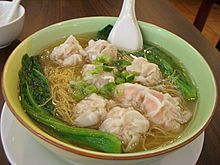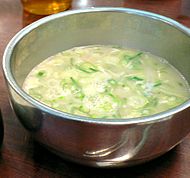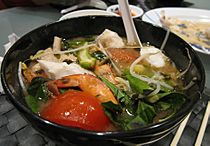Soups in East Asian culture facts for kids
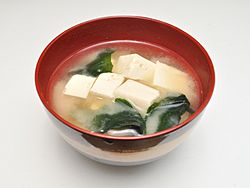
A bowl of miso soup
|
|
| Type | Soup |
|---|---|
Soups are a big part of meals in East Asia. People pay special attention to the stock, which is the liquid base of the soup. Sometimes, the ingredients used to make the stock stay in the soup. These soups usually use broths and don't have dairy products like milk or cream. If they are thickened, it's usually with starches from corn or sweet potatoes.
Asian soups can be either savory (salty or umami) or sweet. A good savory soup is known for its smell and its umami flavor. Umami is a rich, savory taste often described as "meaty" or "brothy." Sweet soups, like tong sui, are enjoyed for their smell, how they feel in your mouth, and their taste after you swallow. Many soups are eaten not just for their flavor, but also because people believe they have health benefits. They are often thought to make you feel stronger or more energetic.
In Chinese, noodle soups are usually seen as a noodle dish, not just a soup. They are called "soup noodles" (湯麵), which means the soup is just a part of the noodle dish. This is different from "dry noodles" (乾麵).
Contents
Why Are Soups Important in Asian Culture?
Many soups are eaten to help people feel better or stronger. They are closely connected to ideas from traditional Chinese medicine. There are many kinds of these "tonic" soups. They can taste strong or light, and be savory or sweet. Sometimes, soups with the same name might have different recipes in different areas. These soups often have meat (like pork or chicken), vegetables, and special herbs.
What Are the Main Soup Bases?
The base of a soup is very important. It gives the soup its main flavor. Here are some traditional soup bases from different Asian countries.
Chinese Soup Bases
Chinese cooking uses several basic soup stocks:
- Jītāng (simplified Chinese: 鸡汤; traditional Chinese: 雞湯; pinyin: Jītāng): This is a basic chicken broth. It's used for most Chinese soups. Sometimes, herbs like liquorice root, red dates, and wolfberry are added to make it even stronger.
- Shòuròutāng (simplified Chinese: 瘦肉汤; traditional Chinese: 瘦肉湯; pinyin: shòu ròu tāng): This is a lean pork broth. It's often used for Chinese soups that cook for a long time (called 老火湯 in Cantonese). This broth simmers for hours with roots, dried herbs, vegetables, and mushrooms. Cantonese people are famous for these long-simmered soups. They often mix ingredients based on Chinese Medicine ideas to boost health benefits.
- Báitāng (simplified Chinese: 白汤; traditional Chinese: 白湯; pinyin: báitāng): This white, milky broth is made from pork bones boiled strongly for many hours. It has a rich and deep flavor.
- Yútāng (simplified Chinese: 鱼汤; traditional Chinese: 魚湯; pinyin: yú tāng): This milky broth is made by frying and boiling fish for several hours. It has a rich feel and a sweet, umami taste.
- Máotāng (simplified Chinese: 毛汤; traditional Chinese: 毛湯; pinyin: máo tāng): This broth uses bones, meat scraps, or skin from pork, duck, or chicken. It's a common broth for simple dishes.
- Special Broths:
- Shàngtāng (simplified Chinese: 上汤; traditional Chinese: 上湯; pinyin: shàng tāng): A dark tan broth made from Jinhua ham, pork, and chicken. It's simmered slowly to create a rich, umami flavor. This broth is used in expensive soups like shark fin soup or wonton soup.
- Diàotāng (simplified Chinese: 吊汤; traditional Chinese: 吊湯; pinyin: diào tāng): A clear white broth made by boiling bones and chicken. It's then made even clearer using finely minced chicken breast. This process can be repeated to make a "double-clarified" broth.
After making Chinese stocks, the ingredients can be cooked again to make a thinner, less strong broth. This is called ertang (simplified Chinese: 二汤; traditional Chinese: 二湯; pinyin: èr tāng; literally "second soup").
Japanese Soup Bases
Most Japanese soup bases are called dashi. They get their flavor mainly from kombu (kelp) and shavings from dried skipjack tuna (katsuobushi). These are soaked or simmered to release their umami flavors. The broth is then strained. Sometimes, mirin (a sweet rice wine) is added to make the taste even better.
- Kombu: Kelp (kombu) is soaked in warm water or simmered to make a light broth.
- Niboshi: Made by soaking or boiling dried sardines (niboshi) in water. The heads and insides are usually removed first to prevent bitterness.
- Shiitake dashi: Made by soaking dried shiitake mushrooms in water.
Korean Soup Bases
Korean broths are known as yuksu(K: 육수 T: 肉水). Even though the name means "meaty water," yuksu can also include broths made from vegetables. Different kinds of broth are used for many Korean soups.
- MyeolChi YukSu (멸치 육수): A clear broth made by boiling dried Korean anchovies. Kelp can be boiled with it for more flavor. This is a common broth for simple Korean soups and noodle dishes.
- GoGi YukSu: This means a clear broth made from boiling meat, like beef, chicken, or pork. It's often used instead of MyeolChi YukSu for a richer flavor.
- SaGol YukSu: A milky broth made by boiling bones for a long time. It's used for hearty, meaty Korean soups like gamja tang(감자탕).
- KimiChi YukSu (김치 육수): A clear broth from traditional Korean kimchi. It's not boiled. This broth usually comes from kimchi with less chili powder, like dongchimi (동치미), which is a sliced Chinese radish kimchi. It's often used for cold noodle dishes.
Indonesian Soup Bases
In Indonesian cuisine, there are many traditional soup bases called kuah. These can come from vegetables, spices, meat, or bones.

- Santan is a rich, creamy, thin white soup made from coconut milk. It's made by squeezing grated coconut flesh. Thick coconut milk is for sauces, while thin coconut milk is for soups. Sometimes turmeric is added for a golden-yellow color. Examples include sayur lodeh and some sotos.
- Kuah asam is a light, fresh, and sour thin soup. It's made from asam jawa (tamarind) juice. An example is sayur asem, a vegetable stew in tamarind soup.
- Kuah cuka: Another sour soup that uses vinegar instead of tamarind. It's often used for seafood soups.
- Sayur bening means "clear soup." It's lightly seasoned with garlic, shallots, and temu kunci. Examples include sayur bayam (spinach soup) and sayur oyong (okra soup).
- Kaldu refers to broth or stock made from boiling meat and/or bones. This can be from chicken, beef, or mutton. Examples include sop buntut and bakso (meatball noodle soup).
Popular Asian Soups
The soup bases are used to cook many different kinds of soups.
American Chinese Soups
In American-Chinese restaurants, some very popular soups are egg drop soup, hot and sour soup, wonton soup, and chicken with corn soup.
Korean Soups
- Yukgaejang (육개장): A spicy red soup with beef strips, red pepper, and vegetables like green and white onions and bean sprouts. Many versions include egg and rice or cellophane noodles. Sometimes seafood is added. It's very popular among Koreans and others.
- Miyeok guk (미역국): A soup made from boiled sliced beef and miyeok (also known as wakame in Japanese). People believe it's good for blood vessels and the heart. Koreans traditionally eat this for birthdays or when a woman has a baby.
- Tteok guk (떡국): A soup with slices of rice cake. The base is usually beef or anchovy stock. It often has sliced green onions and eggs. It's usually served with dried seaweed. Tteokguk is traditionally eaten on the Lunar New Year.
- Doenjang jjigae (된장 찌개): A bean paste soup base. It usually has tofu and green onions. Many versions include other ingredients like meats, fish, potatoes, and vegetables. Miso is a simpler version of doenjang.
- Sundubu jjigae (순두부 찌개): A spicy red stew (more like a thick soup). It's similar to yukgaejang but uses soft, uncurdled tofu (called sundubu) as a main ingredient. It often has more seafood than meat. It's usually served very hot, with more solid ingredients than liquid. Often, an egg yolk is placed whole in the soup.
Indonesian Soups
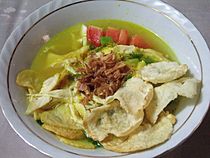
Indonesian soups are known for being very flavorful with lots of bumbu (spice mixtures). Indonesian cooking has many different kinds of soups. Some Indonesian soups can be a whole meal by themselves, while others are lighter.
Indonesian soups and stews are generally put into three main groups:
- Soto are traditional Indonesian spiced meat soups. They can have a clear broth or a rich coconut milk base. An example is soto ayam.
- Sayur refers to traditional vegetable stews, like sayur asem.
- Sop or sup usually means soups that came from Western influences, such as sop buntut.
Nepalese Soups
- Kwāti is a soup made from nine different kinds of sprouted beans. These include black gram, green gram, chickpea, and more. It's a special dish eaten on the full moon day in August.
Vietnamese Soups
Vietnamese cuisine has two main types of soup: noodle soups and broths (Vietnamese: canh).
Noodle soups are eaten for both breakfast and dinner. Popular noodle soups include phở, rice vermicelli soups (like bún bò Huế), mì, bánh canh, and hủ tiếu.
Broths are thin and usually made from vegetables and spices. They are typically eaten with steamed rice during regular lunches and dinners. Common broths include canh chua rau đay and canh chua cá lóc.
Hot pot (lẩu) is a popular traditional soup in Vietnam. In hot pot, meat, seafood, and vegetables are cooked in hot broth right at the table.
A thick, sweet, porridge-like soup called chè is eaten as a snack.
Medicinal Soups and Herbs
Some herbs are often used in soups because people believe they make you feel better, stronger, or help your body fight off sickness. These herbs include wild yam, Astragalus membranaceus, Codonopsis pilosula, Angelica sinensis, wolfberry, and jujube. Ginseng and lingzhi are also used, but less often because they are more expensive.
Many special recipes for tonic soups use other herbs. Some well-known ones are:
- Sijunzi tang (T: 四君子湯, meaning "four nobles soup"): Contains Panax ginseng, Atractylodes macrocephala, Fu Ling, and Glycyrrhiza uralensis.
- Siwu tang (T: 四物湯, meaning "four substances soup"): Contains Angelica sinensis, Paeonia lactiflora, Ligusticum wallichii, and Rehmannia glutinosa.
- Sishen tang (T: 四神湯, meaning "four-divinity soup"): Often cooked with slivered pork stomach. It contains Dioscorea polystachya, Lotus seed, Fu Ling, and Euryale ferox seeds.
- Liuwei tang (T: 六味湯, meaning "six-taste soup"): A sweet soup used to "clear heat" from the body. Ingredients can vary.
- Bazhen tang (T: 八珍湯, meaning "eight-treasure soup"): This soup combines the ingredients from Sijunzi tang and Siwu tang.
- Shiquan tang (T: 十全湯, meaning "ten-complete soup" or "wholesome soup"): Also known as Shiquen dabu tang (T: 十全大補湯, meaning "complete great restorative soup"). This soup adds Cinnamomum aromaticum and Astragalus propinquus to Bazhen tang.
Types of Asian Soups
- Egg drop soup is a light Chinese soup.
- Ginseng soup is very popular in China and Korea. samgyetang (chicken stuffed with ginseng in broth) is a famous Korean dish.
- Steamboat is a shared soup where meat, seafood, and vegetables are dipped and cooked in hot broth right at the table.
- Miso soup is a light broth with miso paste. It's usually served for breakfast in Japan and can include tofu, mushrooms, seaweed, or green onions.
- Shark fin soup is a Chinese soup made with shark's fin, crab meat, and egg. It's often served at big celebrations.
- Dried tofu skin soup is made with Shiitake mushrooms and dried oysters. The soup base comes from pork ribs and/or chicken broth.
- Soto is a traditional Indonesian soup with broth, meat, vegetables, and spices. Some soto recipes use clear broth, while others use coconut milk.
Asian noodle soups are usually a large bowl of long noodles in broth. In Western noodle soups, the noodles are smaller pieces. In Asian noodle soups, the noodles are the main part, while in Western ones, the liquid is the main part.
- Bakso is an Indonesian meatball noodle soup. Beef meatballs are served with rice vermicelli, yellow wheat noodles, and vegetables in beef broth.
- Phở is a very popular Vietnamese noodle soup. Its broth is made by boiling beef bones, ginger, and sweet spices (like star anise, cinnamon, and cloves) for many hours.
- Ramen is a Japanese noodle soup that comes in several different kinds.
- Thukpa is a Tibetan noodle soup. It's a main food there, along with butter tea and tsampa.
- Udon soup has thick, soft noodles in a light broth. There are many types with different noodles and toppings.
|
See also
 In Spanish: Sopas de Asia para niños
In Spanish: Sopas de Asia para niños


